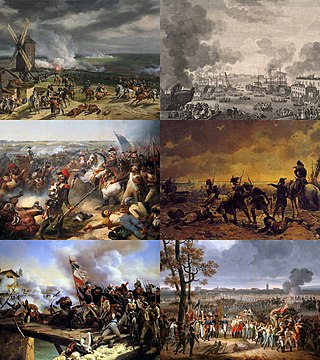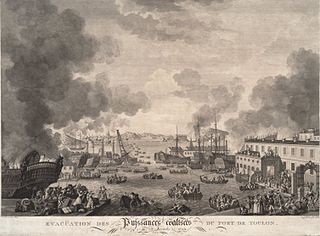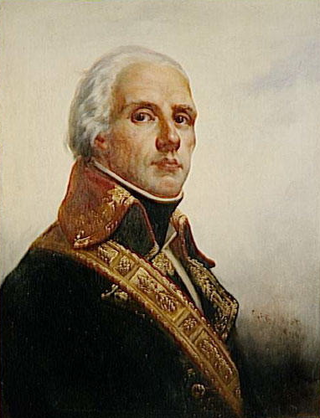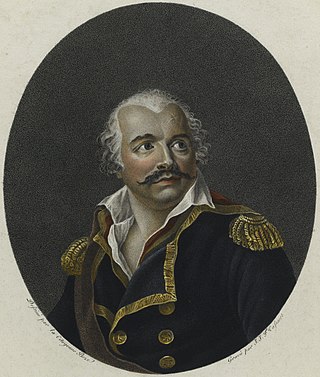
The War of the First Coalition was a set of wars that several European powers fought between 1792 and 1797 initially against the constitutional Kingdom of France and then the French Republic that succeeded it. They were only loosely allied and fought without much apparent coordination or agreement; each power had its eye on a different part of France it wanted to appropriate after a French defeat, which never occurred.

The following is a timeline of the French Revolution.

The French Revolutionary Wars were a series of sweeping military conflicts lasting from 1792 until 1802 and resulting from the French Revolution. They pitted France against Britain, Austria, Prussia, Russia, and several other monarchies. They are divided in two periods: the War of the First Coalition (1792–1797) and the War of the Second Coalition (1798–1802). Initially confined to Europe, the fighting gradually assumed a global dimension. After a decade of constant warfare and aggressive diplomacy, France had conquered territories in the Italian Peninsula, the Low Countries and the Rhineland in Europe and abandoned Louisiana in North America. French success in these conflicts ensured the spread of revolutionary principles over much of Europe.
The French Revolutionary Wars began on 20 April 1792 when the French Legislative Assembly declared war on Austria. This launched the War of the First Coalition.

The French Revolutionary Wars continued from 1793 with few immediate changes in the diplomatic situation as France fought the First coalition.
The French Revolutionary Wars continued from 1794 between Revolutionary France and the First coalition.
The French Revolutionary Wars continued from 1795, with the French in an increasingly strong position as members of the First Coalition made separate peaces. Austria and Great Britain were the main remaining members of the coalition. The rebellion in the Vendée was also finally terminated by General Hoche.

The War of the Pyrenees, also known as War of Roussillon or War of the Convention, was the Pyrenean front of the First Coalition's war against the First French Republic. It pitted Revolutionary France against the kingdoms of Spain and Portugal from March 1793 to July 1795 during the French Revolutionary Wars.

The siege of Toulon was a military engagement that took place during the Federalist revolts of the French Revolutionary Wars. It was undertaken by Republican forces against Royalist rebels supported by Anglo-Spanish forces in the southern French city of Toulon. It was during this siege that young Napoleon Bonaparte first won fame and promotion when his plan, involving the capture of fortifications above the harbour, was credited with forcing the city to capitulate and the Anglo-Spanish fleet to withdraw. The British siege of 1793 marked the first involvement of the Royal Navy with the French Revolution.

The Italian campaigns of the French Revolutionary Wars (1792–1802) were a series of conflicts fought principally in Northern Italy between the French Revolutionary Army and a Coalition of Austria, Russia, Piedmont-Sardinia, and a number of other Italian states.

Jacques François Coquille named Dugommier was a French general.

Jean Baptiste François Carteaux was a French painter who became a General in the French Revolutionary Army. He is notable chiefly for being the young Napoleon Bonaparte's commander at the siege of Toulon in 1793.

The Armée des émigrés were counter-revolutionary armies raised outside France by and out of royalist émigrés, with the aim of overthrowing the French Revolution, reconquering France and restoring the monarchy. These were aided by royalist armies within France itself, such as the Chouans, and by allied countries such as Great Britain. They fought, for example, at the sieges of Lyon and Toulon.

The Low Countries theatre of the War of the First Coalition, in British historiography better known as the Flanders campaign, was a series of campaigns in the Low Countries conducted from 20 April 1792 to 7 June 1795 during the first years of the War of the First Coalition. As the French Revolution radicalised, the revolutionary National Convention and its predecessors broke the Catholic Church's power (1790), abolished the monarchy (1792) and even executed the deposed king Louis XVI of France (1793), vying to spread the Revolution beyond the new French Republic's borders, by violent means if necessary. The First Coalition, an alliance of reactionary states representing the Ancien Régime in Central and Western Europe – Habsburg Austria, Prussia, Great Britain, the Dutch Republic, Hanover and Hesse-Kassel – mobilised military forces along all the French frontiers, threatening to invade Revolutionary France and violently restore the monarchy. The subsequent combat operations along the French borders with the Low Countries and Germany became the primary theatre of the War of the First Coalition until March 1796, when Napoleon took over French command on the Italian front.
Hyacinthe François Joseph Despinoy or Despinois became a French general during the French Revolutionary Wars, but Napoleon Bonaparte removed him from command. Afterward he held minor positions.

The Battle of Caesar's Camp saw the Coalition army led by Prince Josias of Saxe-Coburg-Saalfeld try to envelop a Republican French army under Charles Edward Jennings de Kilmaine. Numerically superior Habsburg Austrian, British and Hanoverian columns converged on the fortified French camp, but Kilmaine wisely decided to slip away toward Arras. The War of the First Coalition skirmish was fought near Cambrai, France, and the village of Marquion located 12 kilometres (7 mi) northwest of Cambrai.
Events from the year 1793 in France.

The Piedmontese Republic was a revolutionary, provisional and internationally unrecognized government established in Turin between 1798 and 1799 on the territory of Piedmont during its military rule by the French First Republic.

The French expedition to Sardinia was a short military campaign fought in 1793 in the Mediterranean Sea in the first year of the War of the First Coalition, during the French Revolutionary Wars. The operation was the first offensive by the new French Republic in the Mediterranean during the conflict, and was directed at the island of Sardinia, part of the Kingdom of Sardinia. Sardinia was neutral at the time, but immediately joined the anti-French coalition. The operation was a failure, with attacks directed at Cagliari in the south and La Maddalena in the north both ending in defeat.

Thomas-Augustin de Gasparin, was a French military officer and député for the Bouches-du-Rhône departement to the National Legislative Assembly and the Convention.














